Monday Poster Session
Category: Stomach and Spleen
P4265 - An Unusual Presentation of Gastric Diffuse Large B-Cell Lymphoma
Monday, October 27, 2025
10:30 AM - 4:00 PM PDT
Location: Exhibit Hall

Valerie Bedsole, MD
Walter Reed National Military Medical Center
Bethesda, MD
Presenting Author(s)
Valerie Bedsole, MD, Chelsea Forbes, MD, Lauren Flax, MD, Seth Dukes, MD
Walter Reed National Military Medical Center, Bethesda, MD
Introduction: Lymphomas account for about 5% of gastric cancers, most commonly mucosa-associated lymphoid tissue (MALT) lymphoma and primary gastric diffuse large B-cell lymphoma (PG-DLBCL). While Helicobacter pylori (HP) is strongly linked to MALT lymphoma, its role in DLBCL remains less clear. PG-DLBCL arise de novo or from untreated MALT, and it most commonly presents in the sixth decade of life in males. We present a rare case of PG-DLBCL in a young woman with HP infection.
Case Description/
Methods: A 34-year-old female from Turkey presented with months of worsening epigastric pain radiating to the right shoulder and rare vomiting. There were no constitutional symptoms. Her exam revealed epigastric tenderness, and pain resolved promptly with omeprazole. Labs noted mild iron deficiency anemia. Computed tomography (CT) abdomen showed focal hypoattenuating mucosal wall thickening of the gastric body prompting referral to gastroenterology. EGD revealed a large ulcerated and friable fungating mass in the gastric body and a smaller polypoid mass in the antrum with diffuse erosive gastropathy (Figures 1 and 2). Biopsies from both lesions were morphologically similar and consistent with PG-DLBCL (positive for CD20, PAX5, and BCL6). Additional biopsies showed gastric intestinal metaplasia, chronic inflammation, and HP infection. PET-CT staging showed localized disease to the stomach and perigastric lymph nodes (Stage II, Lugano classification). Her International Prognostic Index (IPI) score was 2, indicating low-intermediate risk. She was treated with quadruple therapy for HP eradication (HPE) and recommended to undergo 4-6 cycles of R-CHOP.
Discussion: This case offers several clinical insights including the clinical importance of understanding HP prevalence and virulence factors. While the patient presented for care in the United States, she originates from Turkey, a highly endemic country where one nationally representative study found 82.5% of asymptomatic individuals screened with the ¹³C-Urea breath test were positive for HP. Additionally, Turkey has a higher prevalence of virulent genotypes (estimated 71% cagA-positive strains), which are known to increase the risk of gastric cancer. Finally, while emerging data suggests HPE alone may lead to remission in up to 66% of localized PG-DLBCL, the standard of care for treatment of extra-nodal DLBCL remains systemic chemoimmunotherapy, like R-CHOP in medically fit patients, with excellent prognosis (overall and progression free survival of >85%).

Figure: Endoscopic image of a large ulcerated mass with heaped up borders and central depression in the posterior gastric body.

Figure: Endoscopic image of a smaller polypoid mass in the gastric antrum.
Disclosures:
Valerie Bedsole indicated no relevant financial relationships.
Chelsea Forbes indicated no relevant financial relationships.
Lauren Flax indicated no relevant financial relationships.
Seth Dukes indicated no relevant financial relationships.
Valerie Bedsole, MD, Chelsea Forbes, MD, Lauren Flax, MD, Seth Dukes, MD. P4265 - An Unusual Presentation of Gastric Diffuse Large B-Cell Lymphoma, ACG 2025 Annual Scientific Meeting Abstracts. Phoenix, AZ: American College of Gastroenterology.
Walter Reed National Military Medical Center, Bethesda, MD
Introduction: Lymphomas account for about 5% of gastric cancers, most commonly mucosa-associated lymphoid tissue (MALT) lymphoma and primary gastric diffuse large B-cell lymphoma (PG-DLBCL). While Helicobacter pylori (HP) is strongly linked to MALT lymphoma, its role in DLBCL remains less clear. PG-DLBCL arise de novo or from untreated MALT, and it most commonly presents in the sixth decade of life in males. We present a rare case of PG-DLBCL in a young woman with HP infection.
Case Description/
Methods: A 34-year-old female from Turkey presented with months of worsening epigastric pain radiating to the right shoulder and rare vomiting. There were no constitutional symptoms. Her exam revealed epigastric tenderness, and pain resolved promptly with omeprazole. Labs noted mild iron deficiency anemia. Computed tomography (CT) abdomen showed focal hypoattenuating mucosal wall thickening of the gastric body prompting referral to gastroenterology. EGD revealed a large ulcerated and friable fungating mass in the gastric body and a smaller polypoid mass in the antrum with diffuse erosive gastropathy (Figures 1 and 2). Biopsies from both lesions were morphologically similar and consistent with PG-DLBCL (positive for CD20, PAX5, and BCL6). Additional biopsies showed gastric intestinal metaplasia, chronic inflammation, and HP infection. PET-CT staging showed localized disease to the stomach and perigastric lymph nodes (Stage II, Lugano classification). Her International Prognostic Index (IPI) score was 2, indicating low-intermediate risk. She was treated with quadruple therapy for HP eradication (HPE) and recommended to undergo 4-6 cycles of R-CHOP.
Discussion: This case offers several clinical insights including the clinical importance of understanding HP prevalence and virulence factors. While the patient presented for care in the United States, she originates from Turkey, a highly endemic country where one nationally representative study found 82.5% of asymptomatic individuals screened with the ¹³C-Urea breath test were positive for HP. Additionally, Turkey has a higher prevalence of virulent genotypes (estimated 71% cagA-positive strains), which are known to increase the risk of gastric cancer. Finally, while emerging data suggests HPE alone may lead to remission in up to 66% of localized PG-DLBCL, the standard of care for treatment of extra-nodal DLBCL remains systemic chemoimmunotherapy, like R-CHOP in medically fit patients, with excellent prognosis (overall and progression free survival of >85%).

Figure: Endoscopic image of a large ulcerated mass with heaped up borders and central depression in the posterior gastric body.

Figure: Endoscopic image of a smaller polypoid mass in the gastric antrum.
Disclosures:
Valerie Bedsole indicated no relevant financial relationships.
Chelsea Forbes indicated no relevant financial relationships.
Lauren Flax indicated no relevant financial relationships.
Seth Dukes indicated no relevant financial relationships.
Valerie Bedsole, MD, Chelsea Forbes, MD, Lauren Flax, MD, Seth Dukes, MD. P4265 - An Unusual Presentation of Gastric Diffuse Large B-Cell Lymphoma, ACG 2025 Annual Scientific Meeting Abstracts. Phoenix, AZ: American College of Gastroenterology.
